Grade 4
RESOURCES AND SERVICES WITHIN A SETTLEMENT
MUNICIPAL SERVICES
Module 18
Municipal services
A variety of services are rendered to the community by the local government (municipality). Can you think of activities that municipal workers are involved in on a regular basis in your
neighbourhood?
…………………………………………………………………………………………
………………………………………………………………………………………….
…………………………………………………………………………………………
…………………………………………………………………………………………
…………………………………………………………………………………………
…………………………………………………………………………………..
Activity 1
To determine the services that people expect from the municipal authorities [LO
2.2, 2.3]
Divide the class into groups and undertake an OPINION POLL amongst GROWN-UPS to
determine what people expect of a local government. Ensure that people of a lower, middle and higher income-group are interviewed.
Include the following questions:
Give FOUR REASONS why you would rather live in an URBAN ENVIRONMENT than in the
country.
What FOUR SERVICES, according to you, are the MOST IMPORTANT that a municipality
must render?
Which municipal services, do you think, are UNNECESSARY?
ALSO INCLUDE A QUESTION OR TWO OF YOUR OWN CHOICE
Make a list of at least six services that people expect of their local municipality.
……………………………………………………………………………………
……………………………………………………………………………………
……………………………………………………………………………………
……………………………………………………………………………………
……………………………………………………………………………………
……………………………………………………………………………………
The services in a well planned city or large town
Activity 2
To determine which services are the most important [LO 3.2, 3.3]
Table 3.10.
Housing
Electricity
supply
Land for
education
Industrial
land
Recreational Have a quick group discussion and decide on the importance of each of these areas
services. Rate them on a scale of 1 (most important) to 9.A spokesperson for
Sewerage
each group must then point out their three most important services and the
least important one and also motivate the choice.
Refuse
management
Business
centres
Transport
services
Water
supply
Assessment
LEARNING OUTCOME 2: GEOGRAPHICAL KNOWLEDGE
AND UNDERSTANDING
The learner will be able to demonstrate geographical and environmental knowledge and
understanding.
Assessment Standard
We know this when the learner:
describes the importance of access to resources and services for people living in settlements; 2.3 describes how basic human needs were met in the past and at present.
LEARNING OUTCOME 3: EXPLORING ISSUES
The learner will be able to make informed decisions about social and environmental issues and problems.
Assessment Standard
We know this when the learner:
3.2 identifies the factors that influence why some people have better access to resources compared to others in a particular context;
suggests ways to improve access to resources in a particular context.
Memorandum
Municipal services
Refuse removal
Build and repair roads
Parks
Cut grass on sidewalks
Sweep streets
3.7. Waste removal and recycling*
GEOGRAPHY
Grade 4
RESOURCES AND SERVICES WITHIN A SETTLEMENT
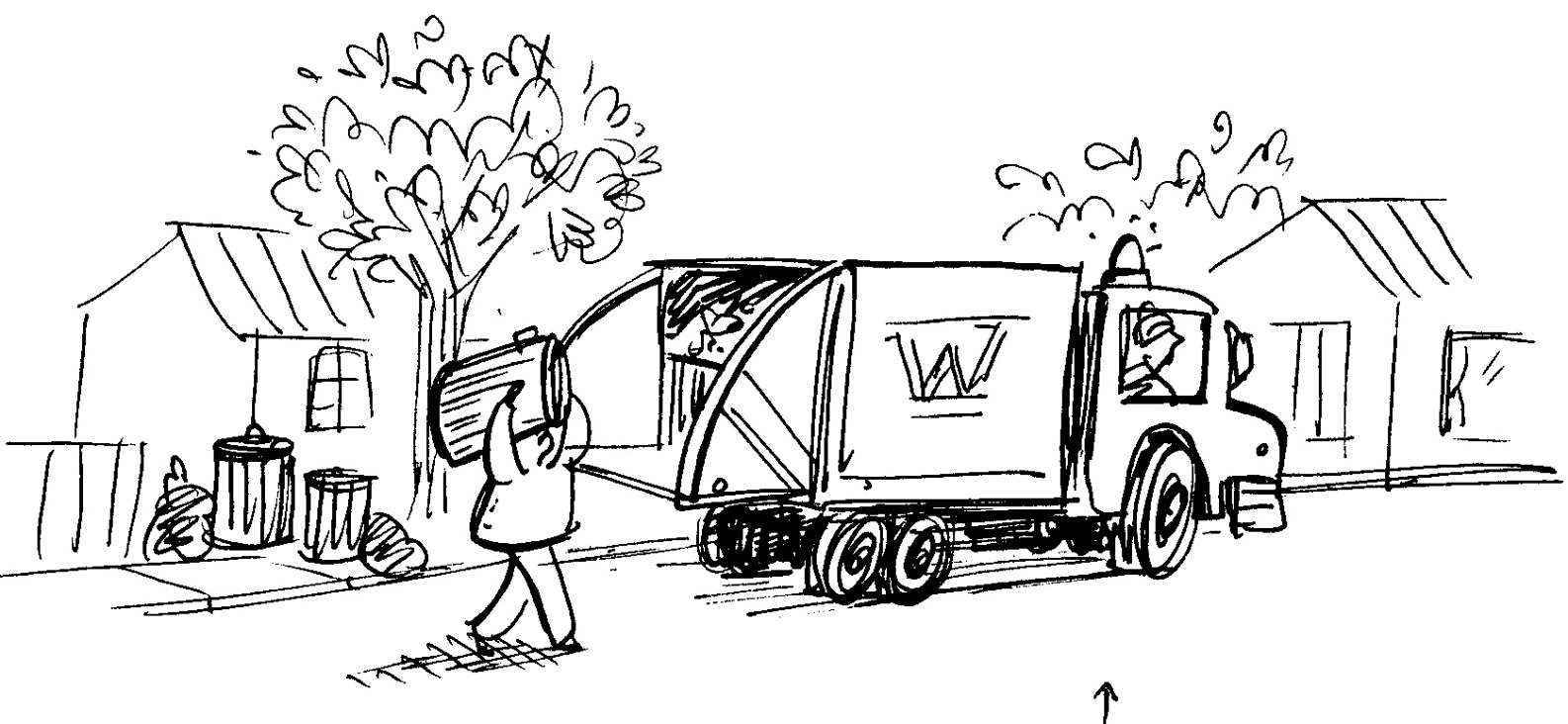
Module 19
WASTE REMOVAL AND RECYCLING
Waste removal
The waste in your environment does not only include the refuse in your refuse bins, but also sewerage waste. Sewerage water contains dangerous germs, and cannot end up in rivers, lakes or the ocean without having been purified. It will have a very harmful effect on plant and animal life.
That is why sewerage water is purified at water-works.
Larger refuse can become a serious problem if it is not removed regularly.
How often does the waste removal truck call on your house?
…………………………………………………………………….
Where is the refuse taken and what do they do with it?
……………………………………………………………………………
Figure 3.6.
Activity 1
To determine how waste is processed [LO 3.1]
Can you make suggestions how to get rid of waste without polluting the environment? Remember, the waste includes plastic (that does not decompose).
…………………………………………………………………………………………………..
…………………………………………………………………………………………………..
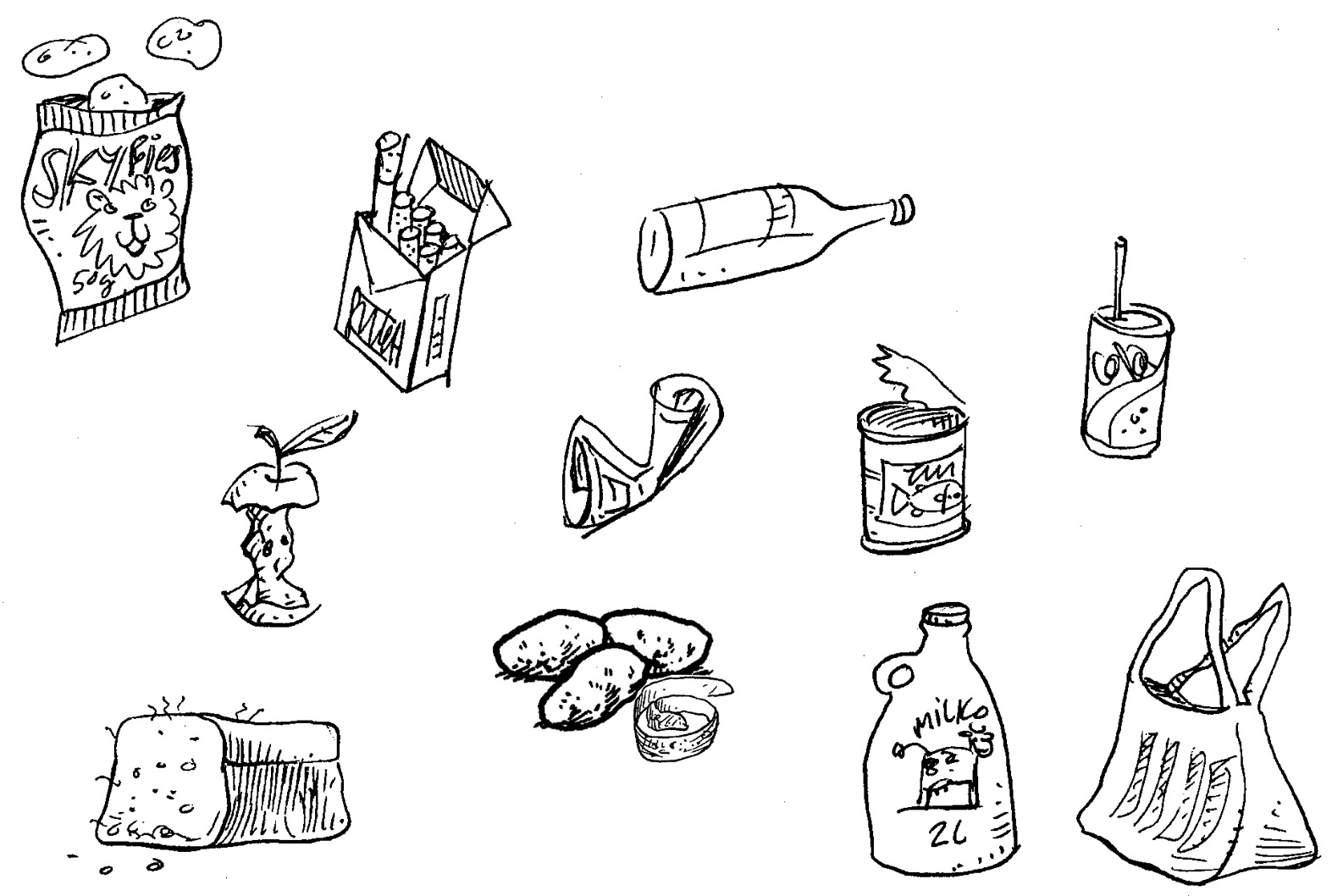
…………………………………………………………………………………………………..
…………………………………………………………………………………………………..
…………………………………………………………………………………………………..
…………………………………………………………………………………………………..
…………………………………………………………………………………………………..
Although most of the waste is taken to dumping grounds where it is either incinerated or buried, it is not always the best alternative.
Recycling
Activity 2
To classify the examples of waste illustrated in this activity, according to the table
[LO 1.2]
Figure 3.7.
Table 3.11.
Reclaimable Non-Reclaimable
Can you make a suggestion on what we should do with the waste in your households?
Interesting facts about the extent of the waste removal services in the city of
Cape Town.
The City of Cape Town’s Task in Relation to Refuse Removal.
The City of Cape Town manages the area from Bloubergstrand to Gordon’s Bay. The refuse from 3,2 million residents as well as that of the factories and businesses is taken from 660 000 service points to six large dumping areas – 1,5 million tons of rubbish per year. This amount increases by 6% each year. The urban population has grown by 3,5% over the past few years. This means that people are producing more and more rubbish each year.
Research has shown that wealthy people generate 25 kg of rubbish per household each week, poor people generate 15 kg per household and the very poorest people in informal settlements generate 8 kg per house.
Unfortunately very little domestic refuse is recycled. People in Europe and the USA generate more refuse but fortunately also recycle much of it.
Remember: the more refuse we recycle, the less we have to get rid of.
Assessment
LEARNING OUTCOME 1: GEOGRAPHICAL ENQUIRY
The learner will be able to use enquiry skills to investigate geographical and
environmental concepts and processes.
Assessment Standard
We know this when the learner:
1.2 organises information under given headings.
LEARNING OUTCOME 3: EXPLORING ISSUES
The learner will be able to make informed decisions about social and environmental issues and problems.
Assessment Standard
We know this when the learner:
3.1 identifies issues associated with resources and services in a particular context.
Memorandum
Waste removal
Refuse dumps (recirculation – decomposition)
Solutions
Chapter 4. Term 4
4.1. The story of food*
GEOGRAPHY
Grade 4
FOOD PRODUCTION IN SOUTH AFRICA
Module 20
THE STORY OF FOOD
The story of food
Food is an important part of our everyday lives. We need food to grow, stay healthy and to stay alive. But there are people whose lives are only focused on food – they live to eat!
Before we look at how food is produced in the 21st century, it is important to find out how our predecessors managed to put food on their plates from day to day.
Activity 1
To study illustrations and fill in missing words in a paragraph to complete a
story about food [LO 2.3]
Table 4.1.
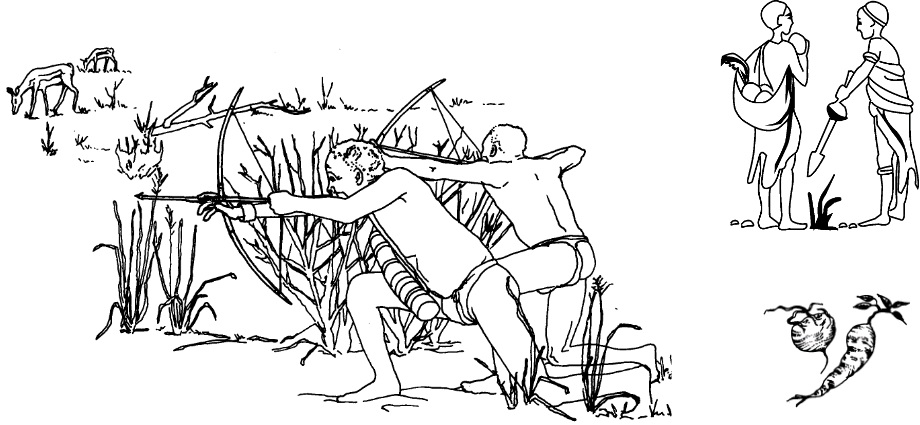

1
2
Table 4.2.
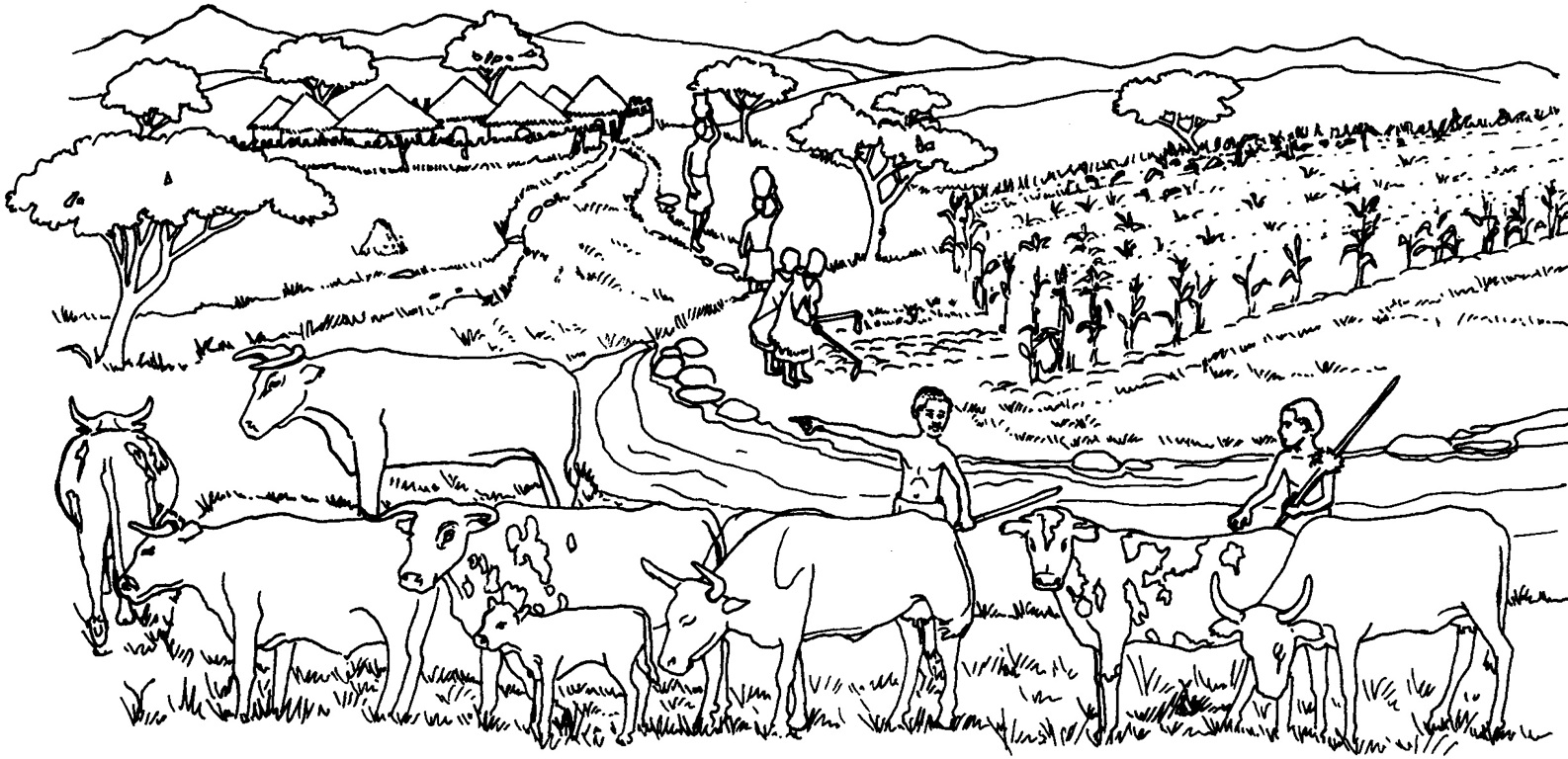
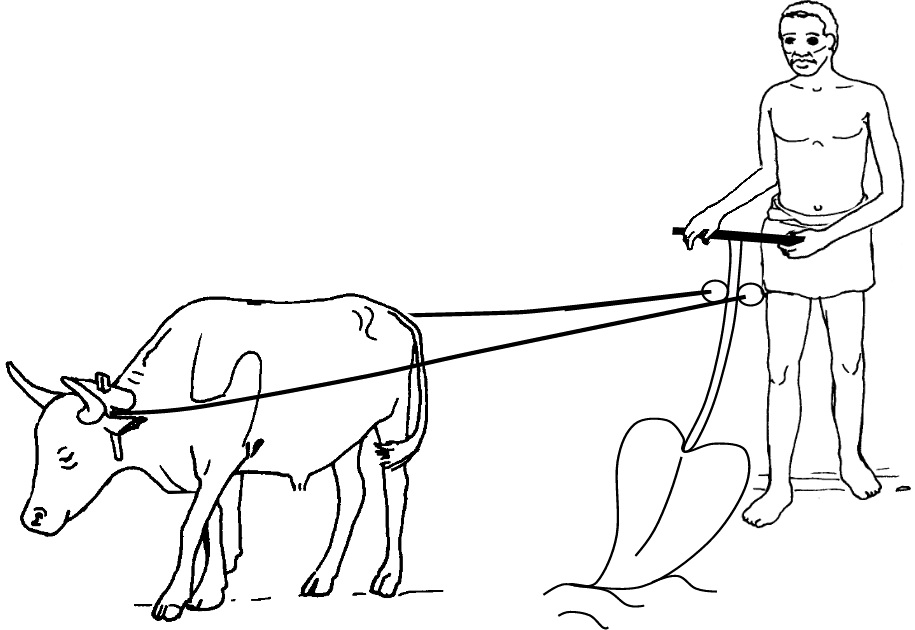
3
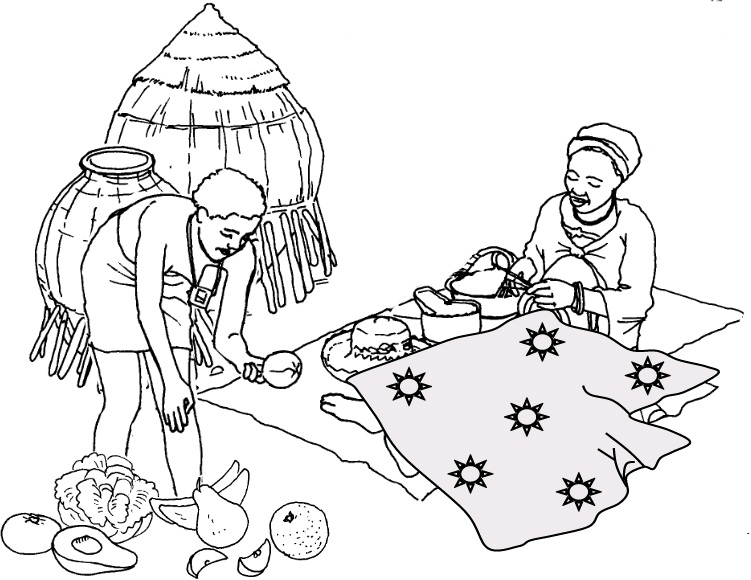
4
5(Possible answers: trade; hunter; herdsmen; wild plants; plough; meat; farmers)
Many years ago, the food that people ate was very different from the food we eat. At first, people lived as .........................................- gatherers who moved from place to place looking for animals to hunt for food. They lived in temporary shelters and when game became less plentiful, they moved to another place. They ate .......................................................... that they picked, with their meat. Their drinking water was gathered by catching rain or dew, or by fetching it from rivers or dams.
The hunters began gathering sheep and goats and herds of cattle, and so became ..............................
who travelled around with their own flocks in search of good grazing. They had milk and
...................................... and did not need to hunt.
The herdsmen became ...........................................… They lived in one place where they could grow their own grain from the seeds of wild grasses. They lived in small groups near fresh water.
They invented the ................................... to help them work the land. They found new ways to transport water to their lands (irrigation). Some of the communities expanded and experimented with different food crops, like maize, sorghum, pumpkins, squashes, wild watermelons, etc.
Portions of the harvests were put away to ensure that they would have food for the whole year and some crops were taken to nearby villages to ........................... it for other food or products.
Farming methods changed with the development of technology. The wooden ploughs of the past
were replaced with iron ploughs. Instead of being pushed by people, up to twenty ploughs can nowadays be pulled by one air-cooled tractor.
Assessment
LEARNING OUTCOME 2: GEOGRAPHICAL KNOWLEDGE
AND UNDERSTANDING
The learner will be able to demonstrate geographical and environmental knowledge and
understanding.
Assessment Standard
We know this when the learner:
describes how basic human needs were met in the past and at present.
Memorandum
The story of food
Hunter
Fruit and seeds
Wild plants
Herdsmen
Meat
Farmers
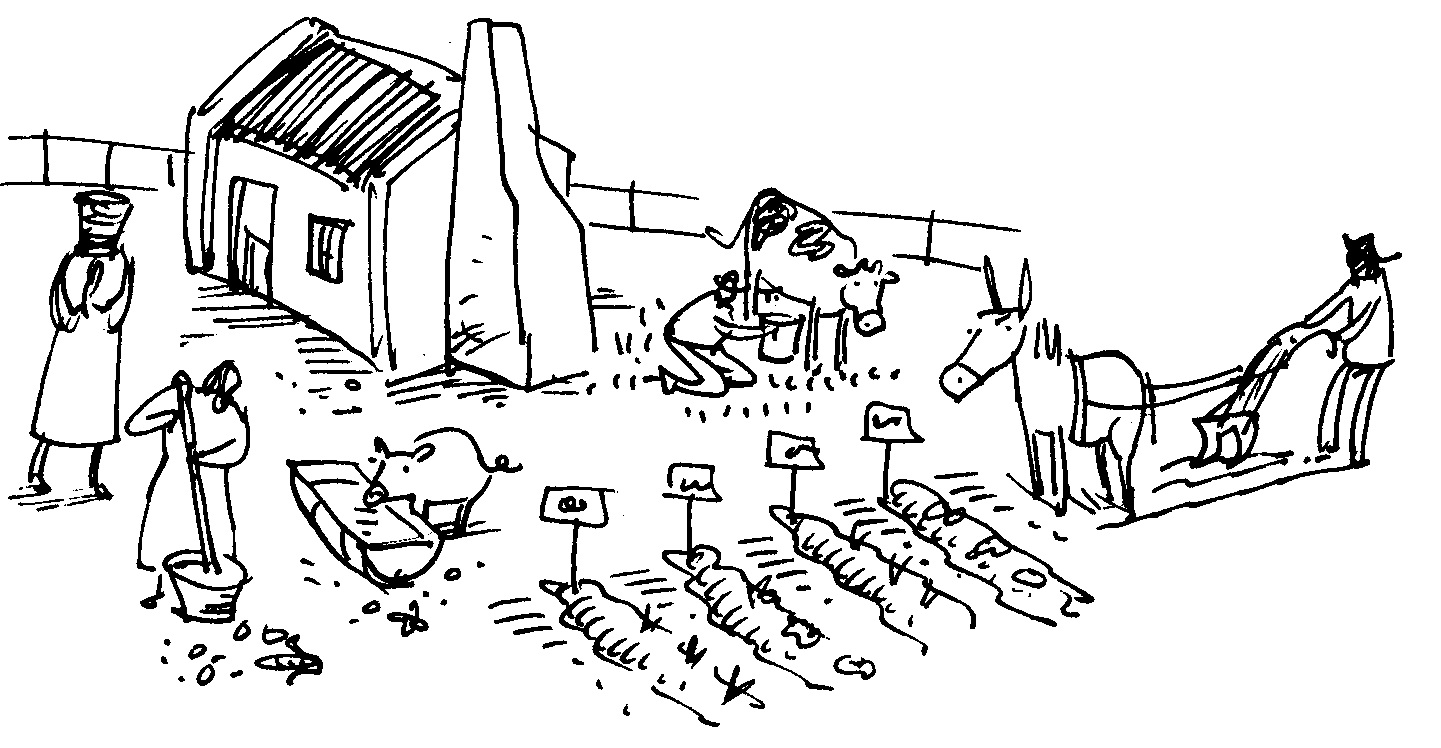
Plough
Trade
4.2. Commercial and subsistence farming*
GEOGRAPHY
Grade 4
FOOD PRODUCTION IN SOUTH AFRICA
Module 21
COMMERCIAL AND SUBSISTENCE FARMING
Commercial and subsistence farming
Figure 4.1.
A
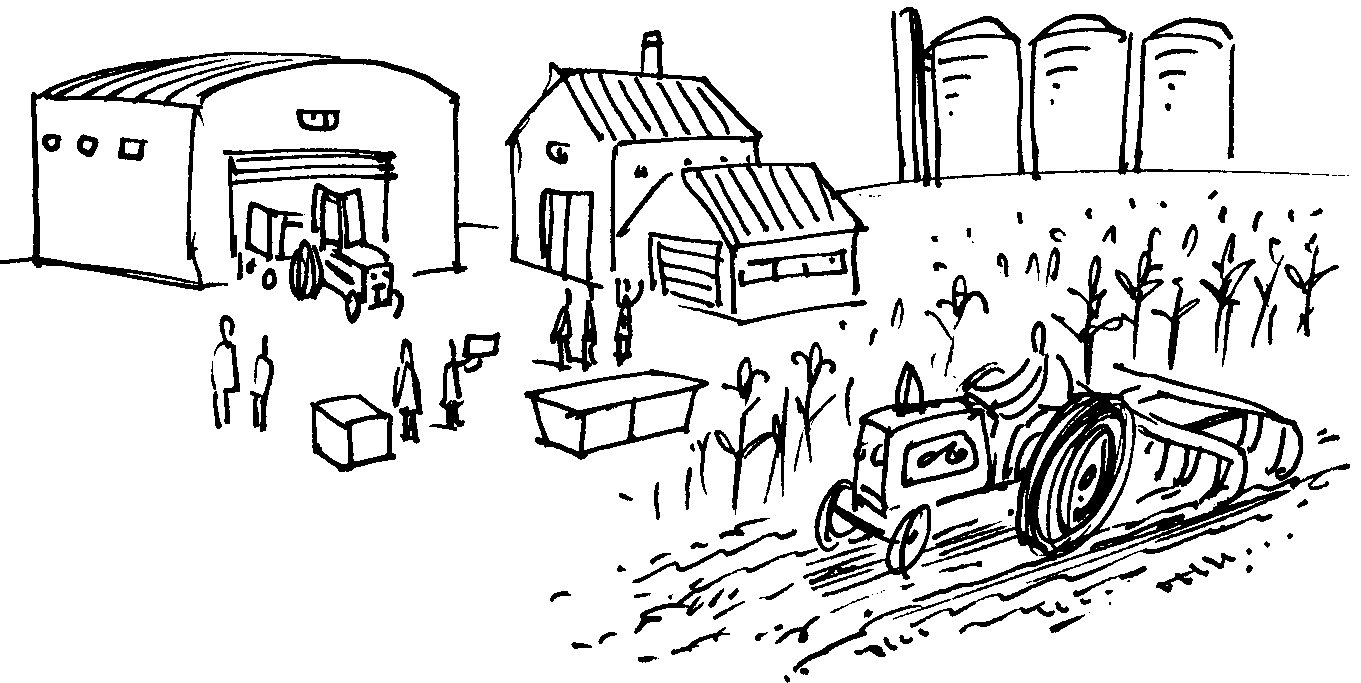
Figure 4.2.
B
Activity 1
To compare sketches illustrating two farms with regard to given criteria [LO 1.6]
Table 4.3.
Sketch A Sketch B
Buildings
Implements
Farming methods
Cultivated products
In sketch A the people living on the land farm to meet their own needs only. They usually do not need a large piece of land. They only produce enough food for their own use. They sometimes have food left to exchange or sell to supply in the need of other people. A variety of crops is planted, and they also provide their own meat, eggs and milk. The farmer and his family do all the work themselves as they do not make a profit from farming and can therefore not pay wages. This kind of farmer is known as a subsistence farmer.
The farmer in sketch B farms with one main crop, namely maize. He produces large quantities that he sells at a profit. He is able to live on the money for a long time and can also buy seed for the next harvest. He does not produce his crop for his own use and therefore buys the food he wants to eat. These farmers are known as commercial farmers and their motive for farming is the profit they can make.
Activity 2
To plan your own subsistence farming [LO 1.7]
Make a list of the basic foods that you need for survival.
…………………………………………………………………………………………………..
…………………………………………………………………………………………………..
…………………………………………………………………………………………………..
…………………………………………………………………………………………………..
…………………………………………………………………………………………………..
…………………………………………………………………………………………………..
…………………………………………………………………………………………………..
…………………………………………………………………………………………………..
…………………………………………………………………………………………………..
…………………………………………………………………………………………………..
…………………………………………………………………………………………………..
You are now a subsistence farmer. Suppose that you have been given a piece of land of
approximately 5 000 square metres (70 x 70 metres or half a hectare) in the southern Cape where the soil is very fertile. There is a farmhouse with all necessary services, a dam, a permanent river and fencing on the land. Remember what the basic foodstuffs that you need for survival are and start planning your farming activities. Draw a plan (map) with a key to show what your farm will look like from the air.
Assessment
LEARNING OUTCOME 1: GEOGRAPHICAL ENQUIRY
The learner will be able to use enquiry skills to investigate geographical and
environmental concepts and processes.
Assessment Standard
We know this when the learner:
1.6 uses information from sources (including own observations) to answer questions about people and places (e.g. “Why is it like that?”) [answers the question];
1.7 uses geographical and environmental concepts and terms to report on enquiries in different ways (e.g. writing a paragraph, using a poster, artwork).
Memorandum
Table 4.4.
Sketch A
Sketch B
Farm homestead and
Buildings
Small house
garageBarnSilos
Implements
Hand ploughHorsePounding block
TractorsPlough-shares
Farming
With manual labourFew labourersSmall
MechanicalMany
methods
scaleSupplies in own needs
labourersLarge scale
Cultivated
Something of everything according to own needs
Focussed on selected crops
products
Milk
Bread
Butter
Vegetables
Meat
Eggs
Make provision for:
Cattle
Sheep
Chickens
Wheat
Maize
Vegetables
4.3. Stock farming*
GEOGRAPHY
Grade 4
FOOD PRODUCTION IN SOUTH AFRICA
Module 22
STOCK FARMING
Stock farming comprises large stock farming (slaughter stock,
dairy cattle and horses), small stock farming (sheep and goats) and
poultry farming (chickens).
Activity 1
To make a list of as many examples as possible of foodstuffs obtained from
animals. You could also make a large poster with examples of the packaging in
which these products appear on the shelves of shops. [LO 1.7]
Make a list of as many examples as possible of foodstuffs that we get from animals. You could also make a large poster with examples of the packaging in which these products are sold in shops.
…………………………………………………………………………………………………
…………………………………………………………………………………………………
…………………………………………………………………………………………………
…………………………………………………………………………………………………
…………………………………………………………………………………………………
…………………………………………………………………………………………………
…………………………………………………………………………………………………
…………………………………………………………………………………………………
…………………………………………………………………………………………………
…………………………………………………………………………………………………
…………………………………………………………………………………………………
Activity 2
To study a map that shows the distribution of large and small stock farming in
South Africa and to answer the questions [LO 1.1]
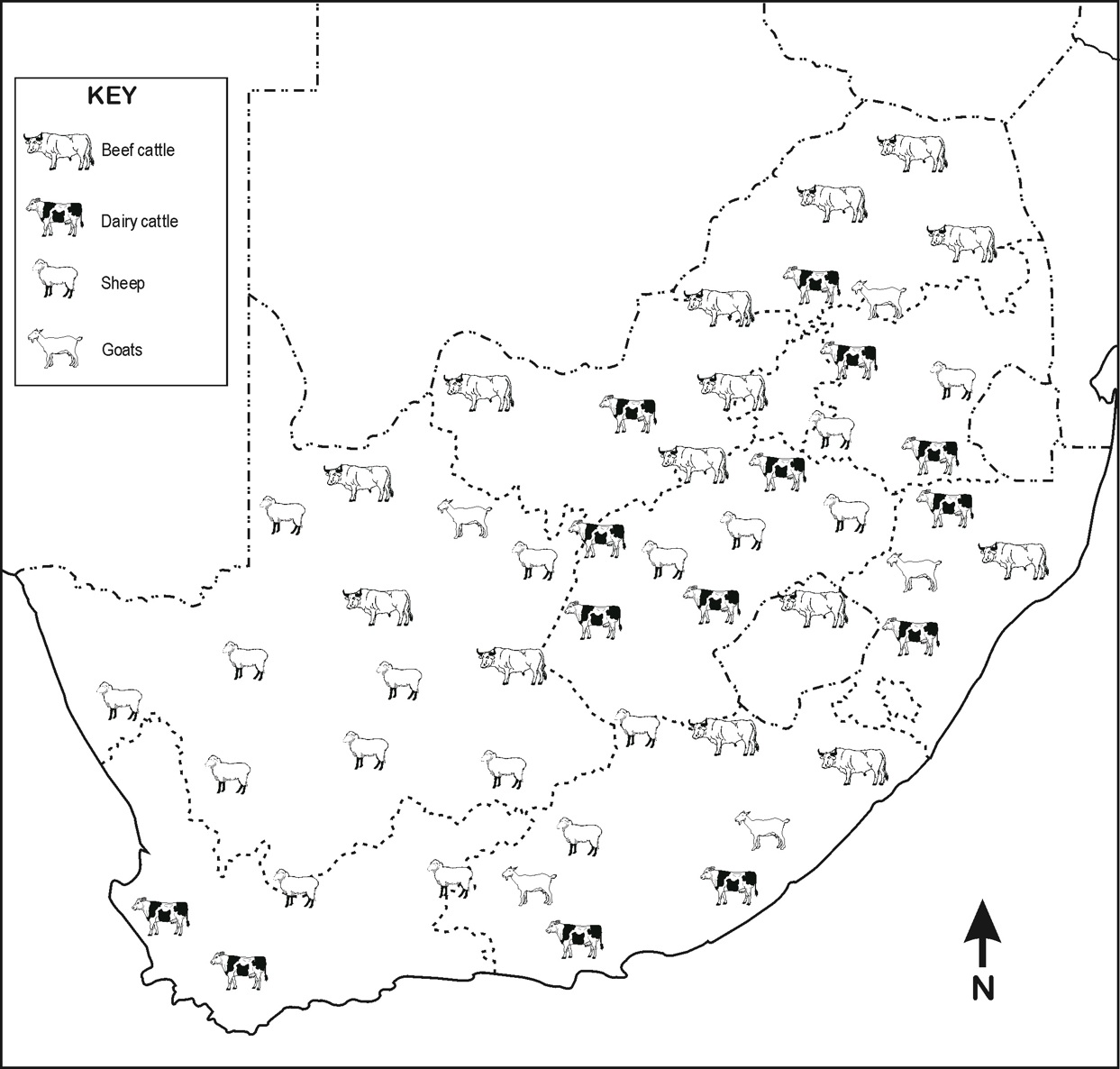
Figure 4.3.
Are their any provinces in South Africa where there is no stock farming?
…………………………………………………………………………….
Where is sheep farming mainly practised? Discuss possible reasons for this in your groups.
…………………………………………………………………………….
…………………………………………………………………………….
…………………………………………………………………………….
What is the main type of stock farming in the Limpopo province?
…………………………………………………………………………….
Can you suggest any reason why there is little stock farming in Gauteng?
………………………………………………………………………………..
………………………………………………………………………………..
………………………………………………………………………………..
Assessment
LEARNING OUTCOME 1: GEOGRAPHICAL ENQUIRY
The learner will be able to use enquiry skills to investigate geographical and
environmental concepts and processes.
Assessment Standard
We know this when the learner:
1.1 identifies information from various sources (maps, atlases, books) [finds sources];
1.7 uses geographical and environmental concepts and terms to report on enquiries in different ways (e.g. writing a paragraph, using a poster, artwork).
Memorandum
The distribution of large and small stock farming in South Africa
No
North Cape and Free State – natural grazing
Cattle
Small – industrial; many cities; little rural areas available
4.4. Poultry farming*
GEOGRAPHY
Grade 4
FOOD PRODUCTION IN SOUTH AFRICA
Module 23
POULTRY FARMING
How frequently does your family have chicken or eggs at a meal? Where does it come from?
Poultry farmers can be divided into two categories:
Table 4.5.
Egg farmers
Table fowl farmers
Produce fowls that are slaughtered for
Definition Produce eggs to sell
their meat.
Cocks and hens are kept, to have
Hens start laying when they are 18
How it
fertilised eggs.
weeks old.
works
Eggs are placed in a hatching chamber
They are kept in batteries.
in a hatchery.
The hen is most productive at 20
Eggs hatch on day 21.
weeks.
Chicks are inoculated against
From week 26 to 28 egg production
diseases.
drops (sold).
Chicks are kept under heaters.
Some are free-range chickens.
Lights are kept burning for 16 hours
Up to 50 000 under a single roof.
per day.
Chicks are fed special food to make
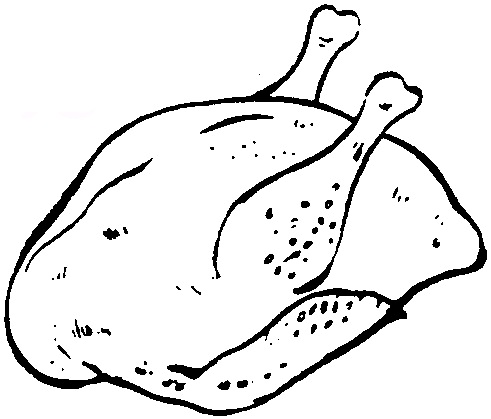
Temperature is controlled.
them grow quickly














